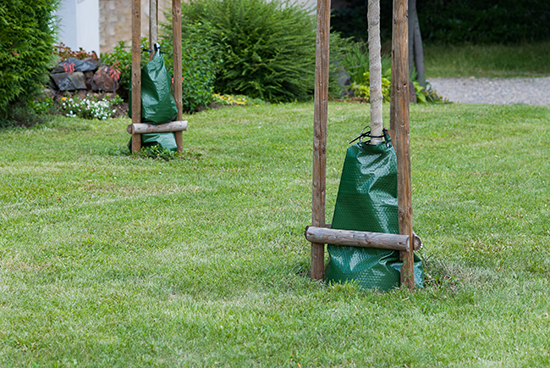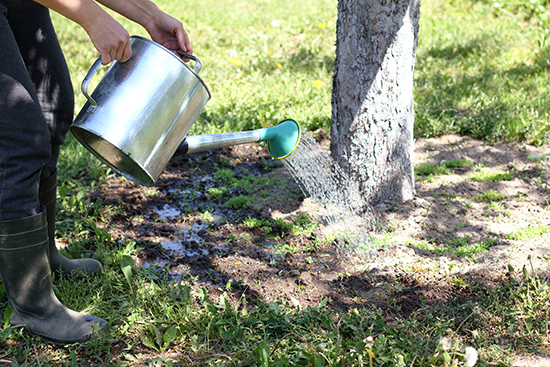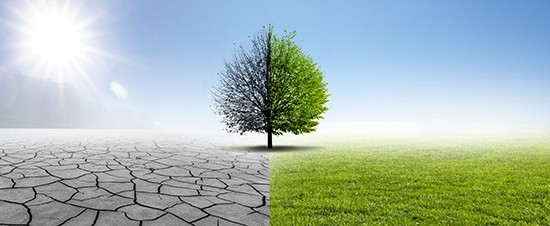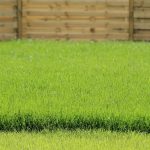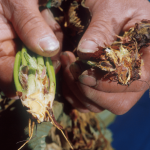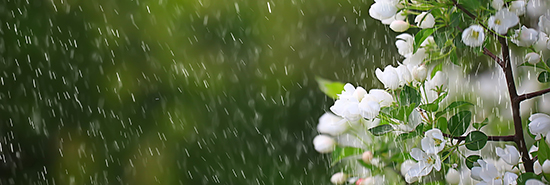
All trees, new and old, need water. If rainwater can’t provide enough, then you will need to water your trees to keep them healthy
Just about every living thing on Earth from animals to plants needs water to survive. When it comes to plants, the water they receive typically comes from rain and humidity. However, mother nature does not always provide enough water for plants and trees as droughts can leave areas dry for weeks or even months. If your area does not receive enough rain, especially during the hot months of the summer, you will need to water your plants and trees to keep them in good health.
People always remember to water houseplants, flowers, and vegetable gardens, but your trees need watering too. This is especially important in a drought as trees that are not drought tolerant are likely to be affected by the lack of water. During dry growing seasons, make sure you include watering your trees in your routine. However, watering trees is not as simple or straightforward as it seems. You need to consider the age and species of your trees as well as the weather, soil condition, and time of year. Overwatering your trees can be just as damaging an underwatering.
In this guide, we will discuss tree watering tips to help you effectively water your trees, especially during a drought. With these tips, you can help ensure that your trees get the right amount of water to grow to their full potential during the growing season. If you want to make sure your trees get the care and maintenance they need each season, including proper fertilization and treatments to help prevent pests and diseases, you can work with a professional arborist like Hendricksen Tree Care. Our tree care professionals will assess the condition of your trees and provide the care and maintenance needed to keep them strong and healthy.
How to Water Trees Effectively
Your trees will get water from the rain, so you want to make sure that your tree watering supplements the water they already receive. Of course, this will differ depending on how much rainfall your area receives each season. The idea is to provide the right amount of water to keep your trees healthy but to avoid overwatering as this can encourage canopy growth that the tree species or soil cannot handle. You also need to water well established trees differently than newly planted trees.
How Much Water do my New Trees Need?
Newly planted trees will especially need watering until the root system has established itself
Newly planted trees need a lot of water to help the root system become established. Generally, new trees are planted with a root ball in which the roots of the tree and soil are balled up in a burlap sack. The soil ball must be kept consistently moist but cannot be saturated for very long. The trick is to give the root ball just the right amount of water and then after a few months, you can water the root ball and the surrounding area under the canopy.
During a drought, it is very important to water your newly planted trees. They may need watering up to three times per week to keep the root ball moist. On a typical 95-degree day during the summer, a newly planted tree can lose 2 to 3 gallons of moisture through its foliage. If these trees do not receive an adequate amount of supplemental watering, they may experience drought stress in only a couple of days.
When watering newly planted trees, you must consider the soil type as certain soil types that don’t retain water as well will need more frequent watering. You need to make sure the soil ball gets the right amount of water because overwatering can cause diseases and water may run off into the soil outside the soil ball. Watering new trees by hand with a hose is not the best watering method as it is difficult to tell how much water you are giving the roots. The following watering tips will water your new trees with a slow delivery method that will prevent the root ball from becoming oversaturated:
- Perforated vinyl bags, also known as drip irrigation bags, are tied around the base of a new tree and filled with water. The perforations in the bag allow the water to slowly drip over the root ball, minimizing water runoff. This method also allows you to measure the amount of water you give your tree.
- The same effect of drip irrigation bags can be accomplished using 5-gallon buckets. Puncture the side of the buckets and place them around the base of the tree. When you fill them with water, the water will slowly drain out of the holes and keep the root ball moist.
- Drip systems and emitters can be used to measure the amount of water given to new trees. These parts can be attached to a battery-operated timer so that they shut off to avoid saturating the root ball. You must also pay attention to the amount of water being given to the tree when using this type of system.
How Much Water do Established Trees Need?
Established trees will also need watering, especially when there has been a lack of rainwater
Trees are considered established once the roots grow beyond the root ball and into the surrounding soil. It may take two growing seasons for a newly planted tree to become established. Once trees become established, they do not need to be watered as frequently as new trees. However, it is still important to ensure that your established trees get enough water from the rain and supplemental tree watering.
When watering established trees, you need to soak the area around the tree out to a couple of feet past the dripline, or canopy. The root system of most trees extends out beyond the canopy which is why you should not stop at the canopy’s edge. When watering, you want to make sure that the soil is moistened to about 10 inches deep. You should avoid watering the area immediately around the trunk because this can cause the trunk to rot.
If you are not sure if your trees need to be watered, check the moistness of the soil around the tree. You can do this by sticking a screwdriver that is longer than 8 inches into the ground. The screwdriver will pass through moist soil easily but get stopped by dry soil. If your screwdriver won’t penetrate the soil beyond 6 inches, you should water your trees. When using continuous flow hoses and sprinklers, you should be mindful of how long these are left on as to not overwater and cause water damage to your yard or home.
You can water your established trees using one of the following methods:
- Garden hose: One way to water your trees is to use a regular garden hose. The best way to use a garden hose is to turn the water down to a slow dribble and leave the hose on the ground near the trunk. After about half an hour, move the hose to a different area around the trunk. Keep moving the hose every 30 minutes or so until you cover the entire area that needs watering.
- Soaker hose: Soaker hoses are porous hoses that leak water out of the entire length of the hose. With these hoses, lay them around the tree and turn on the water until you see beads of water form on the surface of the hose. Let the hose go for at least an hour.
- Sprinklers: Sprinklers are a good way to water your trees, but you need to make sure that they don’t make the leaves wet. The water needs to be supplied to the root system in the soil.
- Bucket: If your hose cannot reach your trees, you can use a bucket to water them. Fill the bucket and dump it slowly and evenly in the area around the tree.
- Mulch: Putting down a layer of mulch that is about 2 to 4 inches deep will help the soil retain moisture. Lay the mulch down out to about the dripline and do not lay any mulch against the trunk.
How Droughts Affect Your Trees
Watering your tree during a drought can be the difference between life or death for the tree
Watering your trees is always important as sometimes there is not enough rainfall to supply your trees with the amount of water they need. When there is a drought, you must water your trees more often and take additional steps to protect them from drought stress which makes them more susceptible to harmful pests and diseases.
A drought is when there is no rain or precipitation in a given area for an extended period of time. Droughts can last for weeks, months, or even years in some cases. During a drought, there is limited moisture in the soil and what little moisture is there is held tightly by the soil and often doesn’t make it to the surrounding plants.
Periods of drought can affect your trees in the following ways:
- Slow or stunt growth
- Reduce production of carbohydrates
- Lower winter energy reserves
- Slow production of chemicals that help protect against pests and diseases
- Kill off foliage and branches of the tree
- Reduce growth of new stems and leaves in following years
The following drought effects will make your trees more likely to succumb to a disease or pest:
- The tree’s physiology may change.
- The tree may no longer be able to produce defensive chemicals to fight off disease.
- Damage or injury to tissues make the tree weak and susceptible to diseases from weaker pathogens.
- Trees in distress often attract harmful insects like borers.
If your area is affected by a long-term drought, you can take the following actions to help protect your trees from drought stress:
- Protect tree trunks from damage from lawn mowers and other equipment. Damage to the trunk can disrupt the movement of water and nutrients within the tree.
- Remove nearby shrubs and plants or avoid planting new plants near your trees to reduce the competition among the plants for moisture.
- Add mulch around the tree over the root zone to help the soil retain moisture. Organic mulch should be applied 2 to 4 inches deep at least out to the dripline. Replace the mulch as needed as mulch will decompose.
- Water your trees more often, especially your newly planted trees. For young trees, give them five gallons of water as well as 5 additional gallons for each inch of the diameter of the tree trunk. Refer to the tips above for more on how to water newly planted and established trees.
- Water your trees during the fall season until the ground is frozen so there is enough water in the soil to survive the winter and start growing the following spring.
- Do not prune or fertilize your trees in drought conditions. Trees exert energy to process nitrogen from fertilizers and heal from pruning wounds. During a drought, they will not have enough water to expend this energy.
- Do not disturb the soil under the canopy of the tree. Any damage or disturbance of the root system will make it more difficult for the tree to get water.
Care for Your Trees with Help from Hendricksen Tree Care
Watering your trees is an important part of tree care that you should never overlook, unless your area has been getting a lot of rain. The above-mentioned tree watering tips will help you effectively water your trees to provide supplemental irrigation and keep them healthy during a drought. In addition to watering, your trees will need the proper maintenance including tree pruning and fertilization to ensure that they grow strong and healthy and can resist pests and diseases.
At Hendricksen Tree Care, our arborists can provide the tree care and maintenance your trees need including tree trimming and fertilization. We will look for signs of pest infestations, diseases, and drought stress among your trees and come up with appropriate solutions for these issues. We provide tree care services in Arlington Heights, Wilmette, Highland Park, Lake Forest, Park Ridge, Palatine, North Chicago, and the surrounding north and northwest Chicago suburbs.
